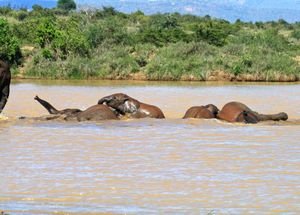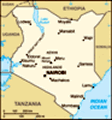Advertisement

 Swimming Trunks
Swimming Trunks
Enjoying a refreshing dip!There is something truly marvelous and unique about stumbling across wildlife in pastoral Kenya. I've visited a number of National Parks and reserves throughout Southern Africa and Kenya and, while sightings of charismatic megafauna are always exhilarating, it's a different experience when it's just part of day-to-day life. Maybe it's the fact that it's not as expected here, that the rarest animal in these parts of Africa is the
mtalii (tourist). These are areas where people and animals are forced to truly coexist, living side by side and in one another's presence; if respect is not shared between one and the other, conflict is inevitable. In many ways, the relationship between people and wildlife is much the same now as it was a thousand years ago (though, in others, it also couldn't be more different - but that's another story). It seems to me that, when most people think of wild Africa, they think of the big game reserves such as the Serengeti or the Maasai Mara, and don't realize the same wildlife that make these parks so famous still roam the rural parts of much of Africa. Granted, densities are highest in the tracts of land set aside specifically for
ecological integrity, but the fact remains that many people have lions and elephants in their backyard. (This is, of course, not from a conservationist's perspective, but merely thoughts on world perception - there remains an infinite amount of conservation work to be done in Africa). Maybe it's just me - but I'll always be amazed by this.
In their backyard! My extended backyard, known as the Laikipia District, is an assembly of ranches and community-owned rangelands that, impressively, support the second highest density of wildlife in all of Kenya (the Masaai Mara ranks #1), as well as the most endangered species in the country. This can make driving to and from "work" (the field) a most fun endeavor. And, because Mpala Ranch is private land (as opposed to a heavily-regulated game reserve), I'm free to drive at any time of the day that I desire (as I've alluded to in my past blogs about nightdrives). Needless to say, I often see some pretty amazing things navigating the dirt roads of the Mpala Ranch.
But the past week and a half or so has been particularly productive. For instance, while driving to our field site this afternoon, Wilson and
I rounded a corner of dense bush to find a family of elephants splashing about in a dam. It was quite a sight - the adults at the water's edge, watching the youngin's gambol in the refreshing water, rolling around in the muddy shallows. The littlest ones seemed to pay no mind to us, enjoying themselves far to much to care about this red intruder. The matriarch and other adults, however, became a bit agitated, flapping their ears in our direction with tusks lowered. We held our ground, knowing this was just a threat display - a mock charge would be our cue to retreat.
It was actually almost comical to watch the interaction between the adults and the calves, and I nearly felt like an old man mistaken for some sketchy pedophilic geezer in a reclining deck chair at the local swimming pool, suspicious mothers taking notice and rushing to the pool's edge to urge their unconcerned and naive children out of his dastardly gaze while casting venomous sideways glances at him. Finally, one of the mothers had to wade in and usher the frolicking youngsters out of the dam in a half-stampede, stopping midway to turn towards

 Spotted
Spotted
Staring contest with a young leopardus and flare her ears with menace. She then continued on her way, and we watched as they crossed the road and calmed down again upon entering the safety of the bush, but not before the largest confronted us head-on less than 50 meters away, like a living and breathing semi squared off in the middle of the road for a game of chicken. At Wilson's revving of our tin-can Suzuki's engine, however, she backed down and followed the others into the bush.
Later this evening, on our way back from the field after our encounter with the ellies, Wilson directed my attention to something he saw disappear behind a bush. I looked out the window to my left and saw, less then ten meters away, a gorgeous young leopard sitting and staring back at me. I was shocked - this leopard could not have cared less about the huge rumbling red beast so close to it, and it promptly flopped down on its side to rest until nightfall. We spent about 45 minutes watching the leopard doze, occasionally glancing up at us and other noises in the vicinity. In the distance, we could hear children from the staff

 Cape Buffalo
Cape Buffalo
Big boy . . . not one you'd want to meet on foot . . .village playing football on the airstrip, and I noticed the leopard's ears twitch and rotate in that direction with every shriek and shout. When it became too dark to clearly see the big cat anymore, Wilson and I drove back to the research center, less than a kilometer away. Informing Jake of our find, he and I decided to revisit the spot with a spotlight and see if the leopard was still lazing away. When we returned to the location, however, it had gone - night had overtaken the bush and it was time to hunt. No matter - we found
two more leopards on a night drive after dinner, including an impressively large and gorgeous male out in the open.
While I have to yet see a lion this trip (though, I hear them often and even came close a couple days ago when one was prowling the main airstrip and field staff for the Laikipia Predator Project were setting up a trap to catch it), I did see the third representative of Africa's big cats the other night. I almost passed it up, too, since I didn't think a pair of narrowly-set green eyes was worth stopping

 Lift Off
Lift Off
Cattle Egrets taking flightfor (95%!o(MISSING)f the time, doing so yields the ubiquitous dik-dik). What grabbed my attention, though, was the fact that there were
four pairs of such eyes quite close together - while dik-diks often come in pairs and occasionally even trios, I've yet to see four in such close proximity to one another. I thought about it for a second and, after asking Jake to stop and back up, could hardly control my surprise and excitement when I saw a beautiful cheetah stand up from the tall grass before slinking away behind some low acacias, followed closely by her three cubs. Not knowing how old the cubs were (they looked quite small), we didn't want to disturb the quartet so only crept slowly over to where we had seen them sitting and found, close by, the scant remains of what we decided must have been a steenbok. Quite a find! And definitely the highlight of a night drive that included, among other things, Bat-eared Foxes and kits, Black-backed Jackal families, a grazing hippo, great looks at a Striped Hyena, the endangered Grevy's Zebra, Reticulated Giraffe, hartebeest, eland, and large rogue Cape Buffalo.
Cattle egrets have started a trend of

 Clawed Frog
Clawed Frog
Looks like Jabba the Hutt . . .roosting in the dead trees in the middle of High Dam, which creates quite a spectacle each evening as hundreds, perhaps thousands of these orange-tinged white birds descend up on the small body of water. It’s a noisy affair, a cacophony of flapping wings, swaying branches, and croaking and barking birds.
Per usual, I’m turning over rocks at every opportunity to look for creepy crawlies, and have been finding some interesting critters as of late: scorpions, spiders, solifuges, crickets, cockroaches, giant millipedes, giant centipedes, termites, and ants to name a few. At the research center, a brief but heavy rain brought out an impressive array of insects and friends, including beetles, mantises, and moths. These, in turn, brought out the insectivores looking for a snack: geckos, solifuges, bats, and a species of clawed frog, which apparently is not an easy thing to see.
While the list goes on, I need to mention just one more notable sighting. The other morning, while driving to our field site, I finally saw one of my "Little Five." (There's the infamous Big Five - lion, leopard, elephant, buffalo, and rhino - so why not a Little Five?). A first I wasn't sure

 Verreaux's Eagle-Owl
Verreaux's Eagle-Owl
Young bird, still downy . . .what it was, what I had seen. My initial reaction was that of total and utter shock, for I thought I had seen a wolverine in the African bush. The creature was all black, stout and solidly built, like a very small and squatty bear. It ran off into the bush as soon as we approached, so that I never got to see its head, but I realized what it was as soon as my first impression was replaced by rational logic: it was a Ratel, also known as a Honey Badger. While not threatened or endangered, these animals can be scarce and frustratingly difficult to see. Furthermore, as I later discovered after consulting the Kingdon Field Guide to African Mammals, the all-black morph is exceptionally rare (they usually sport a whitish or silvery mantle). Closely related to other badgers of the world, Ratel stand apart in being widely regarded at the world’s most fearless animal (at least, according to the Guinness Book of World Records!).
Advertisement
Tot: 0.228s; Tpl: 0.015s; cc: 15; qc: 97; dbt: 0.1317s; 1; m:domysql w:travelblog (10.17.0.13); sld: 1;
; mem: 1.4mb





























Jenni Johnson
non-member comment
Kenya>Lift Valley>Laikipia
Hi Mtalii, you make my entire life in Kenya a big joke! How in the world could you believe people live side by side with animals?? That is just ridiculous!. You choose to tell your exciting story while keeping the already painted picture of dumb Africa. You choose to go to the remote part of the country and speak for the rest of the country - that is no dignity at all.